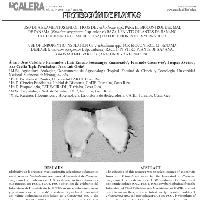Resumen
- El objetivo de la presente investigación fue seleccionar aislamientos endofíticos de Trichoderma spp., para el biocontrol de Fusarium oxysporum f. sp. cubense raza 1. Se evaluaron los tres aislamientos más patogénicos FOC2, FOC4, FOC8 obtenidos del criobanco del Laboratorio de Fitopatología del CATIE, en una prueba de antibiosis y posteriormente se procedió a realizar la prueba de biocontrol con veinte aislamientos endofíticos de Trichoderma spp. y dos aislamientos FOC2 y FOC4 en vitroplantas de Gros Michel (AAA) en condiciones de invernadero. Por medio de la técnica de cocultivo veinte aislados de Trichoderma spp., inhibieron el crecimiento radial de FOC hasta en un 53,46%. En el bioensayo de biocontrol, los aislamientos endofíticos de Trichoderma spp., presentaron un mínimo porcentaje de incidencia con 37,5% del tratamiento TJ5, en comparación al testigo absoluto que no presentó incidencia. Así mismo los tratamientos TC9, TP3 y TCL1 redujeron desde un 92% hasta 90% los síntomas externos en comparación a los testigos referenciales. Los síntomas internos del cormo se redujeron hasta un 74% por el tratamiento TC9. Adicionalmente se detectó que plantas protegidas con los aislamientos endofíticos de Trichoderma spp., promovieron el crecimiento vegetativo de la planta en peso de la raíz y follaje.
- The objective of this research was to select isolates of endophytic fungi of Trichoderma spp., for the biocontrol of Fusarium oxysporum f. sp. cubense race 1. We evaluated the three most pathogenic isolates FOC2, FOC4, FOC8 cryobank obtained from the Laboratory of Plant Pathology and Nematology at CATIE, in a test of antibiosis and then proceeded to test twenty biocontrol isolates of Trichoderma spp., and two isolates FOC4 and FOC2 in vitroplants of banana Gros Michel (AAA) under greenhouse conditions. Through the Coculture technique twenty endophytic fungi inhibited radial growth of Foc up to 53, 46% in comparison with reference control. In the bioassay of Biocontrol, most treatments showed the first symptoms after the third week. Protected plants with endophytic fungi delayed the appereance of the disease until the fourth week. The results showed that endophytic fungi showed a small percentage of incidence being the TJ5 who excelled with the lowest percentage of 37,5%, without showing any symptoms absolute control. Also TC9 endophytic fungi, TP3 and TCL1 reduced from 92% to 90% external symptoms, compared to reference control. Corm internal symptoms were reduced to74% by the endophytic fungus TC9. Additionally it was found that protected plants endophytic fungi in promoting growth in the variables of foliage weight and root weight. DOI: http://dx.doi.org/10.5377/calera.v13i20.1620.
